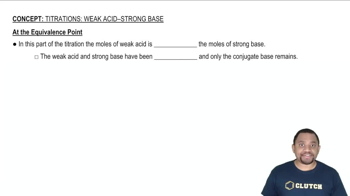Here are the essential concepts you must grasp in order to answer the question correctly.
Titration
Titration is a quantitative analytical technique used to determine the concentration of a solute in a solution. It involves the gradual addition of a titrant (a solution of known concentration) to a sample until the reaction reaches its equivalence point, where the amount of titrant equals the amount of substance in the sample. Understanding the stoichiometry of the reaction is crucial for calculating concentrations and pH at various points during the titration.
Recommended video:
Equivalence Point
The equivalence point in a titration is the stage at which the amount of titrant added is stoichiometrically equivalent to the amount of substance present in the sample. At this point, the reaction between the acid and base is complete, and the pH of the solution can change dramatically. For a weak base like methylamine (CH3NH2) being titrated with a strong acid like HBr, the pH at the equivalence point will be determined by the properties of the resulting salt and the hydrolysis of its ions.
Recommended video:
pH Calculation
The pH of a solution is a measure of its acidity or basicity, calculated as the negative logarithm of the hydrogen ion concentration. At the equivalence point of a titration involving a weak base and a strong acid, the resulting solution will contain the conjugate acid of the weak base, which can affect the pH. To find the pH at this point, one must consider the concentration of the conjugate acid and its dissociation in water, often requiring the use of the acid dissociation constant (Ka) for accurate calculations.
Recommended video:
 Verified step by step guidance
Verified step by step guidance


